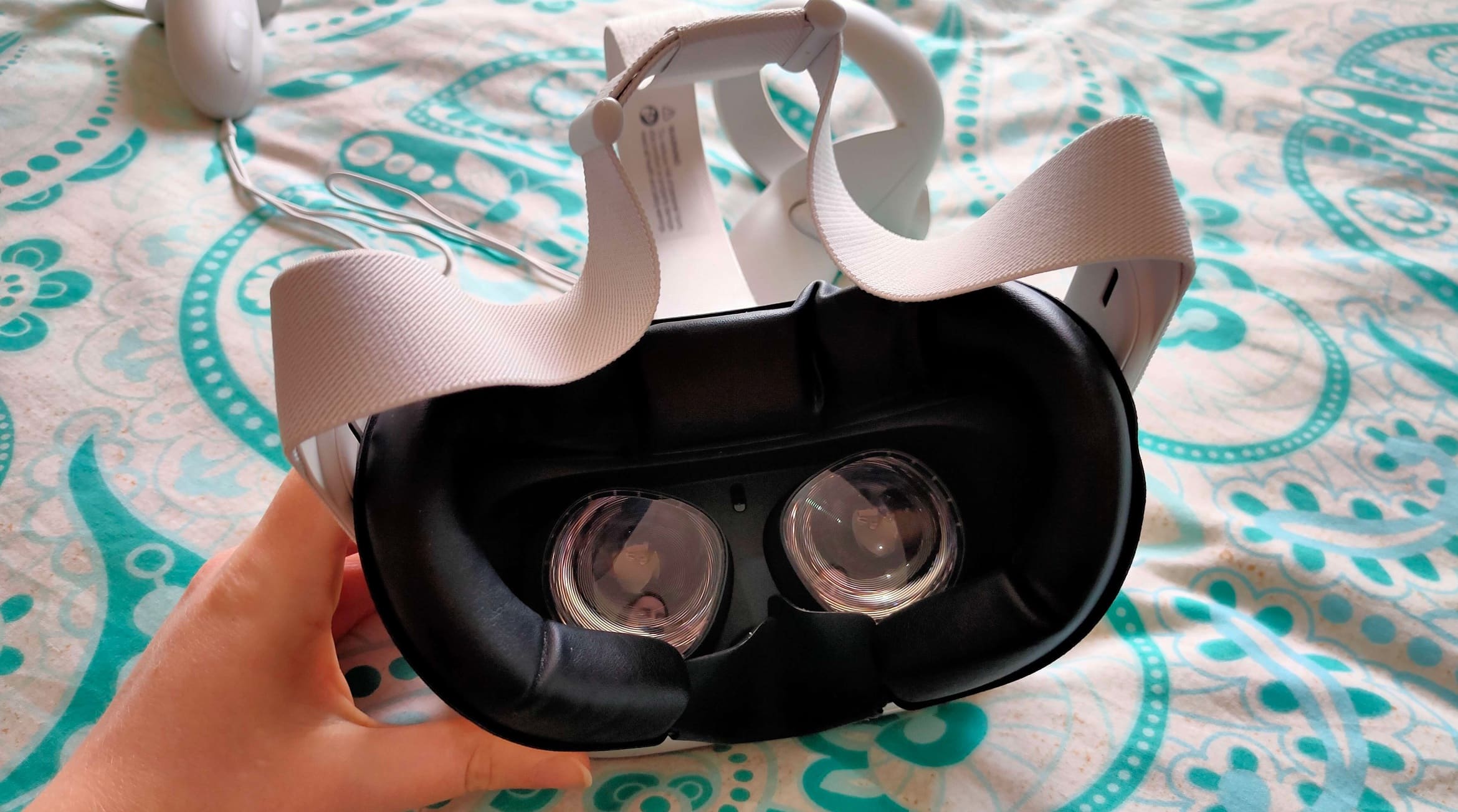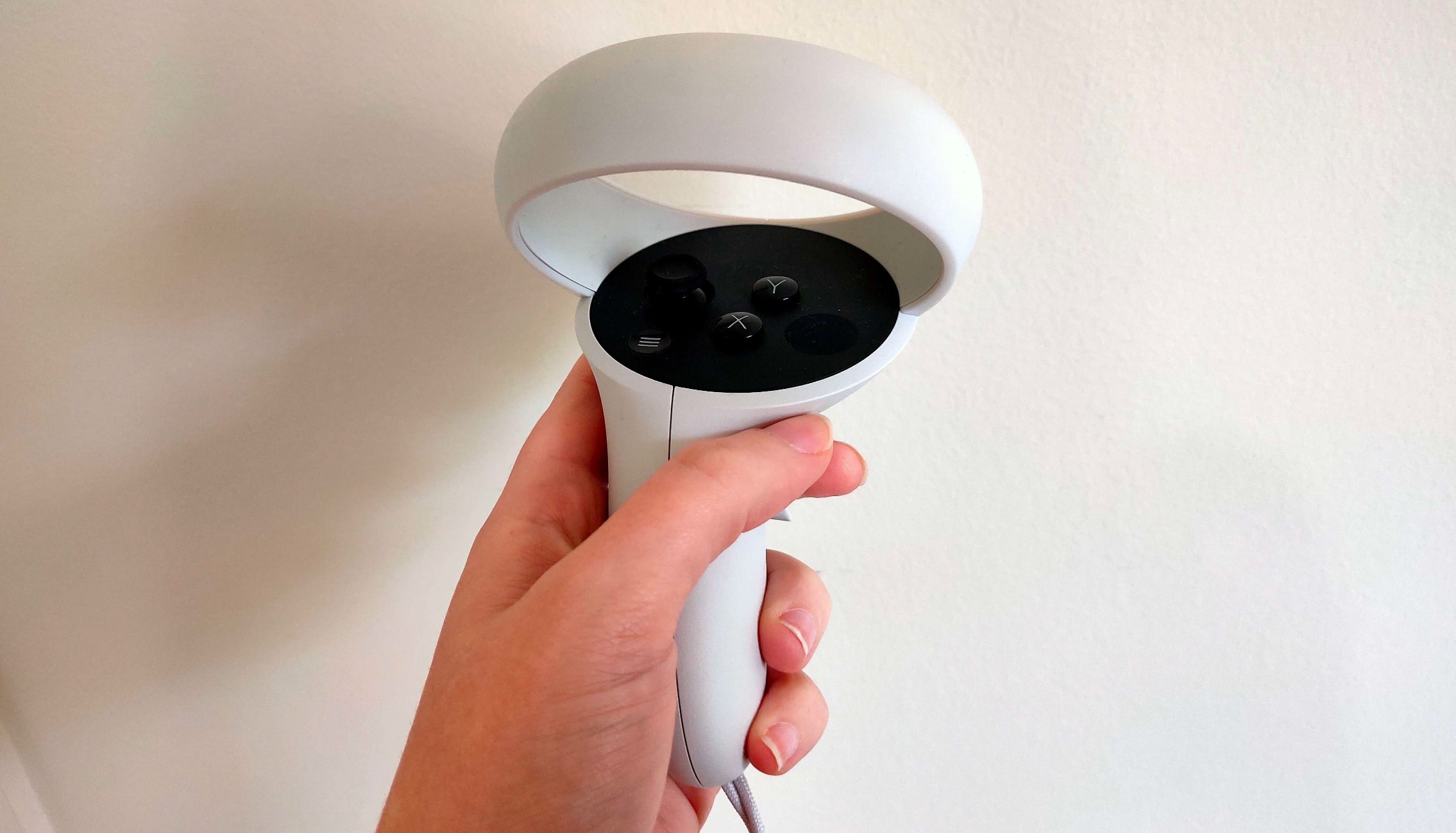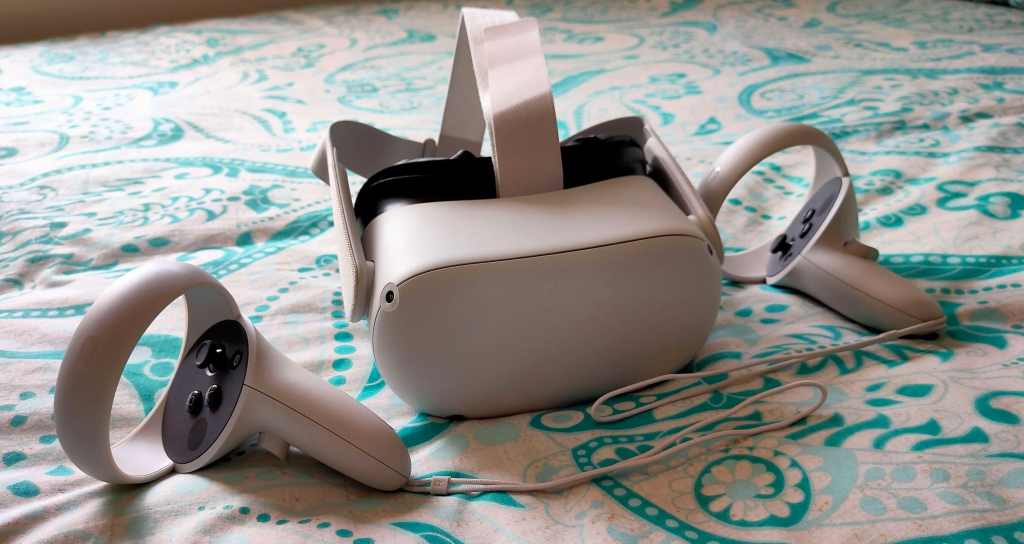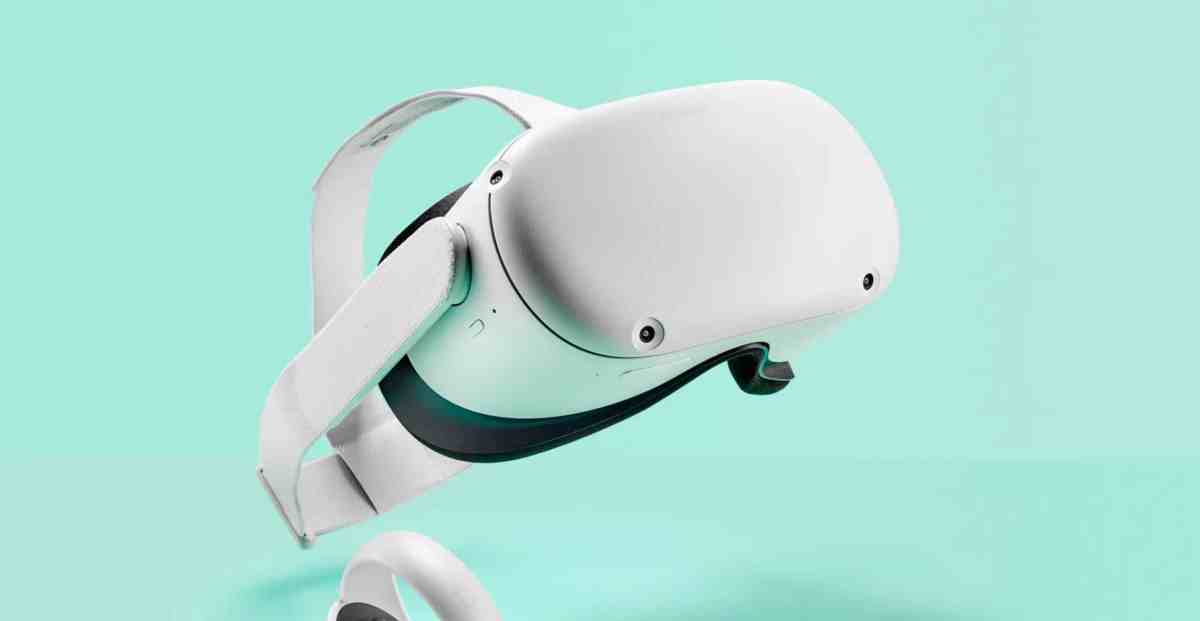In the imagined future, VR is king. We’ll live in virtual worlds, conversing in the metaverse via uniquely designed avatars that represent our ideal selves. We’ll work in VR too, reporting on virtual spaces, or spending time creating items that can be bought and sold – potentially on a blockchain. Our virtual lives will be richer than our physical ones, and VR devices will be our lifeline. The Meta Quest 2 doesn’t quite realise this wild and uncanny vision, often touted by tech gurus and ‘innovators’ – but the hearty device is a compelling and feature-rich stepping stone towards this future.
While the device has recently been given a price bump to contend with global inflation and economic circumstances, it remains one of the most affordable VR devices (AU $629 for the 128GB model; AU $789 for the 256GB model) and the most accessible in the market – in fact, it’s the most accessible on multiple levels, including in easy set-up and gameplay.
The Meta Quest 2 runs straight out of the box – no cables required. All you need to do is fit the head straps over your noggin, adjust for grip strength and comfort, and turn on the device. From there, you’ll be prompted to set up a ‘play area’ where it’s safe to roam – this appears as a glowing outline that warns you of any obstacles – and set up an account.
Previously, a Facebook account was required to run the device, but this is no longer the case. All you’ll need to do is set up a Meta account and a personal profile, and you’re good to play games on the device, either standalone or via connection to a hearty PC. The Meta Quest 2 shines brightest when used as a standalone device, but its PC VR compatibility is also extremely breezy, and opens up the device’s potential.
Meta Quest 2: Comfort and everyday use

The Meta Quest 2 is a very comfortable device – one that’s clearly learned iterative lessons from its predecessors. The three-prong headband is effective in distributing weight, and the bands are soft enough not to cause discomfort, even hours into gameplay. If you have longer hair, you’ll find the bands do slip around – but pop your hair into a ponytail or bun and you’ll have a secure fit, one that never feels too pressured.
That said, it’s likely your face will get warm and sweaty while using the device. Soft, cottony pads rest on your face while using the device, and there is a gap around the nose for air, but the tight seal on the Meta Quest 2 means you’re essentially placing the top half of your face in a slowly-warming air chamber. You’ll sweat around your forehead, the side of your temples, and along the bridge of your nose – eventually creating a wet, hot atmosphere that you’ll need a break from.
I noticed the heat after an hour of gameplay – and took breaks accordingly. You can certainly play for longer and remain comfortable, but if you’re particularly prone to sweating or pressure headaches, you will need to take frequent breaks. The device itself is not particularly heavy or hard to manoeuvre thankfully, but the heat will likely get to you before other typical VR bugbears.
In my time with the device, sweat was my only major challenge – and truthfully, this was a nice change from headsets I’ve used in the past, which have made me sick or woozy. In contrast to VR devices of the last generation (my primary device is a PlayStation VR), the Meta Quest 2 features crisp and focussed graphics. It’s also got adjustable eye toggles that bring the eye screens closer or further apart, depending on your eye distance. This made all the difference for cleaner visuals, which translates to more enjoyable gameplay experiences.
With the Quest 2’s ‘closest’ eye setting, I was able to view completely crisp graphics and text, with no light haloing or blurring. It meant playing games on the device was less visually taxing, and that I was able to play for longer without breaking – until the sweat built up, at least.
Meta Quest 2: Battery life and charging

The battery life on the Meta Quest 2 was another solid feature. Gaming on the standalone device means you will need to take breaks often – whether for heat, headaches, or as a natural consequence of VR experiences being bite-sized – and it means you’ll be picking up and playing the device on an irregular basis. That works totally fine for the battery, which has great power retention, and easy charging.
When you’re using the device in full-flight (for example, playing a game like Superhot VR), around one hour of gameplay will eat up 30-40% of the battery. That means you’ll get between 2-3 hours of gameplay before you need to pop your device on charge again.
That might not seem like much, but given the device is only comfortably used in 1-2 hour stretches, the battery life isn’t a major issue. Many VR games also operate in those aforementioned bite-sized chunks, which don’t lend themselves to marathon gameplay sessions. In my time with the device, the battery rarely became an issue, as I was more likely to hop in for a brief VR session before hopping out again.
Pop your Meta Quest 2 onto charge when it runs out, and you’ll wait around 2 hours for a full battery charge – or use it in smaller bites, and charge as you go for easier pick-up-and-play access.
The controllers, charged separately, run on replaceable batteries and didn’t run out of charge in two solid weeks of use (around 1-2 hours of gameplay every day).
Meta Quest 2: Games library and VR experiences

Using the device standalone, you can purchase a range of VR titles on the Meta Quest Store – but you can also use Air Link over Wi-Fi to connect to a gaming PC, or use a physical Link Cable for the same experience. This gives you seamless, easy access to VR games via Steam and other stores. The set-up here was simple and easy, and only required a quick log in – making the entire process smooth and problem-free. Personally, I preferred to use the Meta Quest 2 as a standalone device – for convenience, mostly.
Within the headset, you’ve got a hearty home page and simple access to the games store, alongside all your purchases.
The current VR games library spans a variety of genres: you can go wandering in Skyrim, become a wily super spy armed with killer gadgets in Superhot VR, become a dancing, planet-saving journalist in Space Channel 5 VR: Kinda Funky News Flash!, or even shoot monsters in Resident Evil 4 VR. I dove into each of these experiences during my time with the Meta Quest 2 – and all were entertaining to varying degrees.
Space Channel 5 VR is essentially a rhythm-based alien battler – using the Meta Quest 2, you can raise your arms to mimic dance moves, and defeat waves of aliens by shaking your arms and bouncing to the groove. The tracking on the Meta Quest 2 controllers is perfect, replicating your bodily movements with zero latency or accuracy issues – when your hand moves, the controller moves. If you skip the beat or perform poorly, it’s always on you. There’s no blaming sloppy tools here.
With the Meta Quest 2 allowing you to mark out a ‘safe space’ to dance within, you’ll also never run the risk of punching at a lightbulb, or smashing your way through a settee. If you’re anxious about room to move, you can poke your head out of the safe space, and the Meta Quest 2’s cameras will illuminate the room around you, and any obstacle in your way. Once you’re in the clear, you’re good to dance again.
Games like Beat Saber were similarly impressive – this rhythm action game lets you play through songs in Tap Tap Revenge or Guitar Hero-like action, swinging your controllers to the beat of tunes, and hitting coloured blocks to advance. Again, the Meta Quest 2 motion tracking proved worthy here, with each swing and twitch recorded well by the controller sensors.

Superhot VR was another highlight – in this action puzzle game, you play as a hero working to take down enemy hordes that only move when you move. Twist to the side, and you’ll watch your world come to life as villains tumble down stairs or across roofs, guns and knives in hand. Pause, and the world stops with you – allow you space and time to assess your surroundings, choose your favourite weapon, and throw down in perfect, crisp VR realms.
Moving quickly can dislodge the Meta Quest 2 from your forehead, depending on how tightly pressured you have the headset – but as long as you’ve got a secure fit, you can weave and dodge like your life depends on it. In Superhot VR, the crispness and aesthetics of the game are so convincing that being shot between the eyes by a rogue bullet genuinely makes you jump – it’ll confuse your brain for the first few minutes, but once you’ve got your rhythm down, it’s easy to lose yourself in this world.
Read: New details confirmed for PlayStation VR 2, including ‘see-through view’
Where the power of the Meta Quest 2 is dulled – and this is an issue for wider VR, not just this device – is in playing games with free-roaming movement. In Resident Evil 4 VR, you have two movement options: teleporting, or free movement. Teleporting feels odd and janky, and you’re more likely to end up in a wall than where you want to be. Free movement is a better option, but comes with an uncanny sway that immediately causes headaches.

The human brain is a powerful tool, but VR gameplay often stumps it – there’s something about ‘moving’ in a virtual space, without your physical body moving, that causes a strange sense of discomfort in most people. In this case, I was most people – and I ended up feeling incredibly ill and developing a headache after just 10 minutes of free wandering in the game.
It meant I largely stuck to the experiences that VR does best – stationary puzzles, adventures and challenges where players stand still as a virtual world moves around them.
This is where the world of VR gaming thrives – but it is also a key limitation of the technology. There are only so many ways you can make gameplay fun if you’re strictly tied to a central locale – and it feels like VR is currently stagnating for this reason. Whether the next iteration of software can improve on the janky movement and headache-inducing motion of unmoored VR gameplay remains to be seen – but it’s certainly not a problem solved by the Meta Quest 2.
For all its innovations, the device is still held back by the fairly strict limitations of VR gaming.
Meta Quest 2: Final Verdict

The Meta Quest 2 is an impressive VR device that packs plenty of power as a standalone headset. While the overall lack of genuinely eye-opening VR experiences do hold the system back – it doesn’t quite feel like VR is living up to its best potential yet – it’s still a robust and entertaining device with a multitude of purposes.
It can immerse you in strange new worlds, make you feel like a real-life super spy, or zen you out with calmer, more mindful experiences. It’s not quite a game changer, but the Meta Quest 2 is an extremely accessible and easy-to-use VR device that promises a brighter virtual future for everyone.
Four stars: ★★★★
Meta Quest 2
Developer: Meta
Price: AU $629 for the 128GB model; AU $789 for the 256GB model
Release Date: Available Now
GamesHub was loaned a Meta Quest 2 unit for the purposes of this review.





